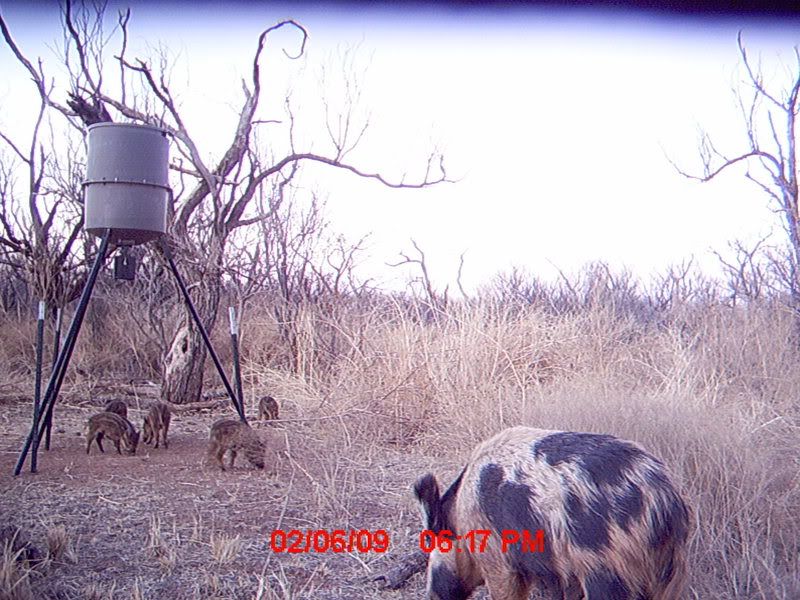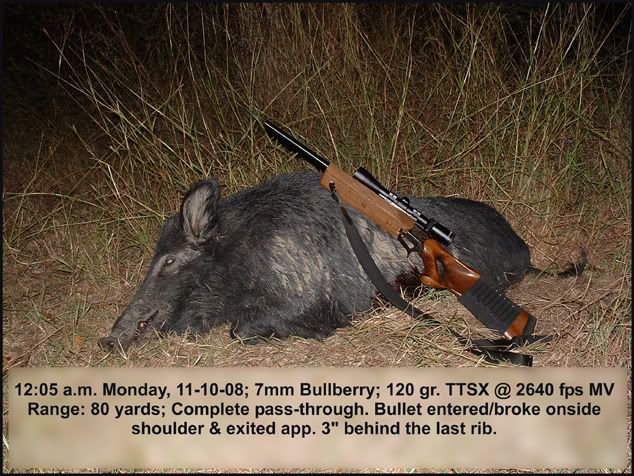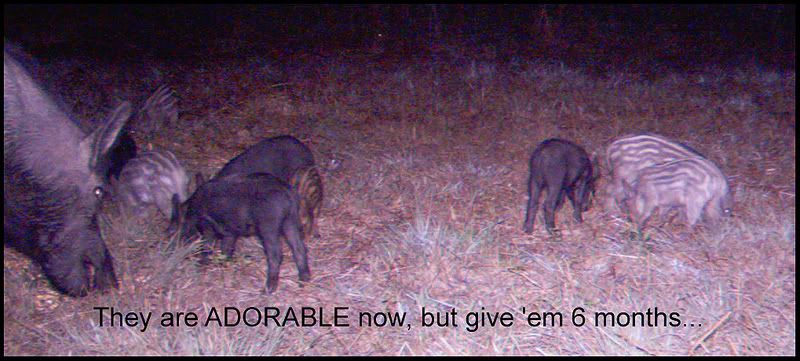

 The Accurate Reloading Forums
The Accurate Reloading Forums  THE ACCURATE RELOADING.COM FORUMS
THE ACCURATE RELOADING.COM FORUMS  Hunting
Hunting  Hogs, Warthogs, Wild Boars, Javelinas Hunting
Hogs, Warthogs, Wild Boars, Javelinas Hunting  Feral vs. European genes
Feral vs. European genesGo  | New  | Find  | Notify  | Tools  | Reply  |  |
| one of us |
 Here's a photo of a sow with her pigs at a feeder in West Central Texas. The sow is known to be the dame of the pigs in the photo because the owner of the camera killed her and two of the pigs just a week or so after this photo was taken. Notice how "domestic" she appears with her black and gray spots. However, her litter is striped just like those of European Boar. We know of no releases of European stock in the area. While I know that all domestic swine pretty quickly (in just a few generations) revert to their wild appearance when they go feral, I question getting stiped piglets from a spotted sow in just one generation. Can we assume that she was bred by (1) a boar whose ancestors have been feral for many generations, or (2) a boar bred from an unknown release of European stock? Opinions (even screwy ones) welcome! | ||
|
| One of Us |
I hope this is not screwy sounding. Piglets like these are found in NW Fl in the big bend area all the way up to Tallahassee and I assume elsewhere. As they mature they become all black and it happens in two generations. No Europeans are involved, it simply is dominant genes winning back it's proper place where it was before Man got involved. All hogs came from Europe originally. | |||
|
| one of us |
Ol Miss, I agree with your observation, and I would expect the piglets in the photo to turn all-black as they mature. However, I'm still a little puzzled that they are all so consistently brown-striped out of a mother which is gray spotted. You would think you might see some mottling on some of them, wouldn't you? | |||
|
| One of Us |
There is a wildlife refuge not far from my place in E. Texas ( Gus Engling Wildlife refuge). My understanding is that they imported wild hogs into that eco system 20-30+ years ago. They used to have hunting draws for them. The state may have done this in other sanctuaries as well. That could be the source of the genetics. I believe after 5-6 generations they just about revert to their origins anyway. They are not to safe to encounter on a dark highway at night either. A big pig can cause considerable damage to your vehicle. EZ | |||
|
| Moderator |
Could one of the parents of the sow be a Dalmatian? "Ignorance you can correct, you can't fix stupid." JWP If stupidity hurt, a lot of people would be walking around screaming. Semper Fidelis "Building Carpal Tunnel one round at a time" | |||
|
| One of Us |
As one of the earlier responders mentioned, it is just the species reverting back to the original blood line. Withe the exception of the Vietnamese Pot Belly and some of the other domectic breeds from South East Asia, the "Normal Domestic Breeds and the Feral Hog" are all Sus scrofa. Over the past 12 months or so, I have seen some game cam pictures posted on other sites, that showed both the brown/red with light stripe piglets, but also greyish colored piglets with light stripes, and they appeared to be from the same litter. Because pigs were "Domesticated" so long back, but never to the point that cattle or dogs were, the reversion rate may be different across the board with some animals changing quicker than others, possibly even among piglets from the same litter. Even the rocks don't last forever. | |||
|
| Moderator |
I do believe that in many cases there has been some Euro-hog blood mixed in at some point as many wild hogs in the US have characteristics of European boar. I agree that they do revert back to a degree what they used to be, but I think some mixing also took place. "Ignorance you can correct, you can't fix stupid." JWP If stupidity hurt, a lot of people would be walking around screaming. Semper Fidelis "Building Carpal Tunnel one round at a time" | |||
|
| One of Us |
Oh Yes, there was some mixing took place, most of it occurred as I described, some of the exotic ranches here in Texas, purchased full blood european stock from places like the San Diego Zoo, and the put them in closures that were not escape proof. Also, if I remember correctly there was a place or two in Tennessee that was a Private Game Park and they brought in some pure blood european stock, and some of those animals and some of their offspring escaped thru the years. I do not know if anyone has actually donne a study odf feral hogs to see how quick they can revert to a wild state and what physiological changes they under go and how fast. Even the rocks don't last forever. | |||
|
| Moderator |
There was an outfit in Missouri that trucked them in from Canada as well....... I saw a special on the National Geographic channel about feral hogs (they analyzed the Hogzilla debacle), and if I can recall correctly, they said that within a few weeks there were some physical changes taking place. No other animal goes feral as quickly nor changes physically as fast. Remarkable critters! "Ignorance you can correct, you can't fix stupid." JWP If stupidity hurt, a lot of people would be walking around screaming. Semper Fidelis "Building Carpal Tunnel one round at a time" | |||
|
| one of us |
Look at the ears. That hog, despite the oddball coloration, is no doubt a few generations from the pen, so to speak. Then look at the photos below. I swiped these from the "Decent Hogs" thread (https://forums.accuratereloading.com/eve/forums/a/tpc/f/1621043/m/7311056101/p/1).  These have big, floppy ears and body mass/shape consistent with pen-raised porkers. They may have been out in the wild, but they obviously haven't been out there very long. (I am not saying they were tame or a canned hunt; I am simply stating these do not exhibit characteristics or attributes consistent with hogs that have been in the wild for much greater periods.) Below is a hog taken in late 2008. It is typical of the hogs in the area I hunt: long, narrow snout, a defined taper towards the hindquarters, the appearance of a hump above the shoulders, a long, straight tail and rather small but perky ears.  Bobby Μολὼν λαβέ The most important thing in life is not what we do but how and why we do it. - Nana Mouskouri | |||
|
| one of us |
 \ This is a game cam photo from last summer. There were 2 sows (only 1 shows in this pix), each with a litter. Both sows were solid black. Also, not all striped piglets wind up being black. I caught a piglet that was mere days old around 2000, and it was dark brown with black stripes. It wound up being a dark, reddish brown adult. The stripes began to fade around 2.5 months. Bobby Μολὼν λαβέ The most important thing in life is not what we do but how and why we do it. - Nana Mouskouri | |||
|
| one of us |
Thanks for all of the photos and comments. I tend to favor the theory that the "European" look in both the adults and the offspring tends to come more from successive generations of life in the wild than from interbreeding with imported wild stock. But I still don't quite understand such a domestic looking sow with so very wild looking pigs. I suppose that the "domestic" appearance can crop out many generations later (thus the appearance of the sow), while the dominant appearance of the original wild bloodline is showing in the offspring. OR, the sow could be only a few generations in the wild, while the boar that bred her could be dozens of generations wild. At any rate, I'll agree that Durocs and Hampshires can change their looks faster than any other mammal I'm familiar with. | |||
|
| One of Us |
Do you guys think the "Razorback" evolved from a domestic population or introduced into the Arkansas/ Missouri area? I never heard of that species being so prolific as feral hogs. Perhaps some of the folks from eastern Europe may chime in on this question. Are the wild boar over there having up to 3 litters a year? This issue may be of our own doing. Developing a high producing species for human consumption that did not exist normally in nature. EZ | |||
|
| One of Us |
Ref 3 litters a year in Europe, yes it is possible and does happen, but is not condoned. By that I mean, the leading female Sau's are not shot purposely, as she leads and controls when the Saus in the group get bred. You shoot the leading Sau and you've broken the group up with no leader, they cause more damage, and get bred whenever. The piglets are just like kids without parents, they tear stuff up when Ma's not around -------- There are those who only reload so they can shoot, and then there are those who only shoot so they can reload. I belong to the first group. Dom --------- | |||
|
| Powered by Social Strata |
| Please Wait. Your request is being processed... |
|

Visit our on-line store for AR Memorabilia

